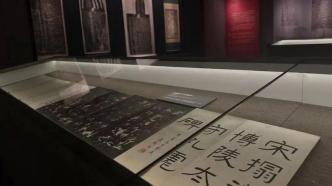
The Shanghai Library's major annual exhibition that has attracted much attention - "The Heroes of the Han Dynasty - Exhibition of Rare Books on Han Steles collected by the Shanghai Library" opened in the East Building of the Shanghai Library this morning (October 30). This exhibition is the first major exhibition on steles and calligraphy held in the East Building of Shanghai Library. The exhibition hall of more than 900 square meters is hung with scrolls of Han steles on all sides, which is magnificent.
As the first special exhibition of rare Han steles at home and abroad, the exhibition selects 90 rare and rare steles from the Han Dynasty collected in the above picture, including tablets, tablets, cliffs, stone monuments, portraits and inscriptions, etc., among which they have reached the national first and second level. About 80% of the standard cultural relics are on display for the first time; this exhibition is also the highest-standard exhibition of cultural relics on Han stele rubbings to date, including the finest Han stele rubbings, such as "Yi Ying", "Ritual Vessels" and "Kong Zhou" Famous monuments such as "Shi Chen", "Cao Quan", and "Zhang Qian" are also selected from remote cliffs such as "Ode to the West", "Ode to the Stone Gate", "Ode to the Yige", and "Liu Pingguo Cliff".

exhibition site
The quantity and quality of exhibits are unprecedented.
As one of the most important public collections of inscriptions and inscriptions at home and abroad, the Shanghai Library has a collection of 250,000 epigraphic and stone rubbings, including 3,000 rare books. In recent years, the Shanghai Library has devoted itself to the compilation and research, publication and exhibition, and publicity of inscriptions. Following the 2019 "Colorful Ink and Stone Drums - New Year Exhibition of Rare Books on Stone Drums" and the 2021 "The Weather of the Tang Dynasty - Exhibition of Rare Books on Tang Steles Collection of Shanghai Library", this year we launched "The Magnificent Style of the Han Dynasty - Rare Books of Tang Stele Collection in Shanghai Library" Exhibition of Rare Books on Han Monuments".

exhibition site

Entrance to the exhibition hall of the East Building of Shanghai Library
"This exhibition of rare books on Han steles is on display in the new building of the Shanghai Library. The area is much larger than the exhibition on rare books on Tang steles two years ago." said Tong Yanfang, deputy president and curator of Xiling Seal Society, "Shanghai The library has a rich collection of Han stele, but even this cannot fully represent all categories of the Shanghai Library's collection of Han stele."
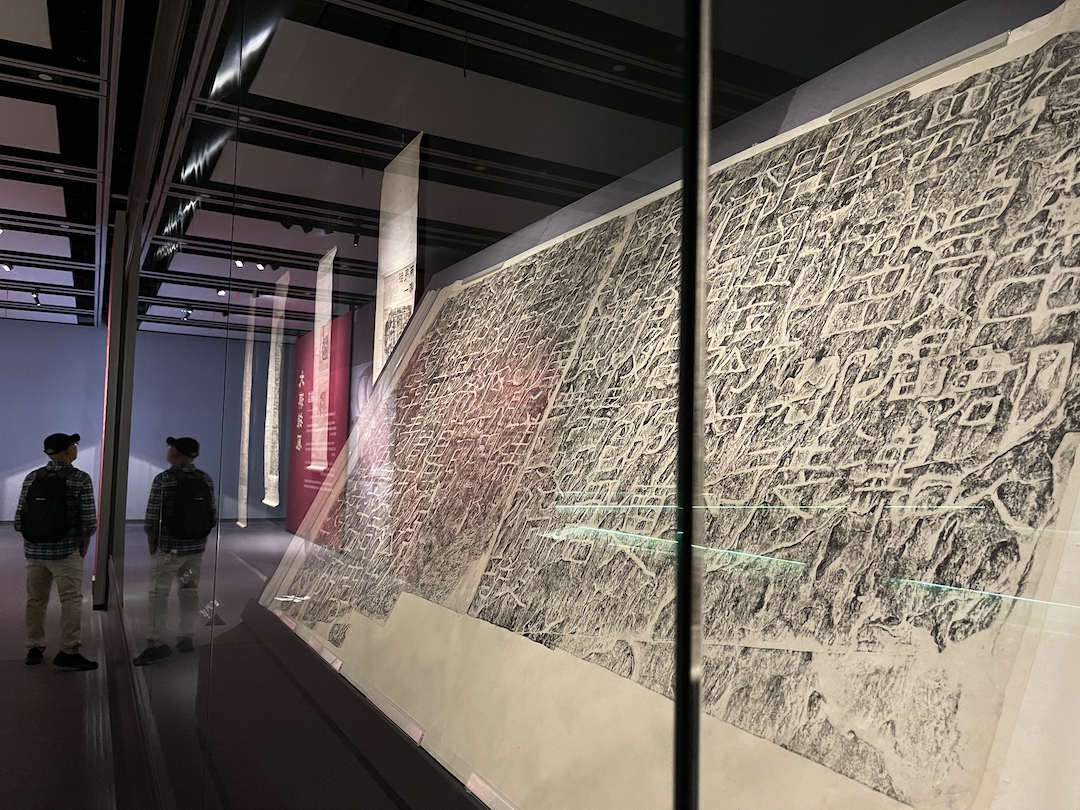
A huge rubbing of "The Cliff of Hajun's Kaitong Baoxie Road"

The Portrait of Jun Che and the Yin (Postscript of Zhou Dalie)
The first exhibition hall of the East Building of Shanghai Library, where this exhibition of rare books on Han monuments is held, covers an area of more than 900 square meters, and the exhibition hall is magnificent. Entering the exhibition hall, a collection of treasures pops up in front of you one after another, as if you are being led through history 2,000 years ago. The exhibition space is divided and combined around the shapes of Han steles, and is divided into sections such as carved stones, tablets, stone towers, cliffs, tablets, stone scriptures, and portrait stones.

exhibition site

exhibition site
As one of the highlights of this exhibition, nearly half of the Han stele scrolls are hung on the wall with a shocking momentum. Tong Yanfang said that hanging and displaying the Han stele scrolls can restore the original appearance of the stele. The number of words on the rubbings, the mounting art, and the inscriptions of celebrities can be clearly seen by viewers. The display effect cannot be achieved by displaying the rare books flatly.
Zhong Wei, an expert and curator of inscriptions from the Shanghai Library, also mentioned that the hanging scroll display format of Han stele is a major feature of this exhibition of Han stele. “The collection of inscriptions on inscriptions became popular in the middle and late Ming Dynasty. Good inscriptions are actually made into mounted copies, because the inscriptions are used for copying and are easy to read on the table. Judging from the more than 90 exhibits in the entire exhibition hall, The weight of the mounted copy is also more important, and the level of cultural relics is higher, but as the Shanghai Library is a public library, in terms of convenience for readers to view, the entire rubbing seems to have more dissemination effect."

exhibition site

exhibition site
According to Zhong Wei, the Shanghai Library has a large collection of Han stele rubbings, accounting for about 20% of the total collection of stele rubbings. "Showing the complete variety of Han stele and the richness of the rubbings in the collection is not the main purpose of this exhibition. Showing the preciousness and scarcity of the Han stele rubbings in the collection and the unique cultural connotation of the rare books on inscriptions are the biggest wish of holding this exhibition." Zhong Wei said.

exhibition site

exhibition site
This exhibition includes the finest steles from the Han Dynasty, such as "Yi Ying", "Liu Utensils", "Kong Zhou", "Shi Chen", "Cao Quan", "Zhang Qian" and other famous steles. It also selects the famous remote cliff "Xi" "Ode to the Narrow", "Ode to the Stone Gate", "Ode to the Ying Pavilion", "Liu Pingguo Cliff", etc. These exhibits benefited from more than thirty years of basic compilation and research discovery. They were carefully selected from thousands of rare books on inscriptions and inscriptions. The existing rare books were mounted There are also high-quality scrolls, which not only reflect the research value of epigraphy, but also have the value of artistic appreciation.
According to Zhongwei, due to the difference in the time of transmission and early spread, the rare books of Han steles and the rare books of Tang steles show different characteristics. Tang steles are treasured with Song rubbings, while Han steles were deeply rooted in people's hearts by the Ming Dynasty. By the middle and late Qing Dynasty, many Han dynasty stone carvings were unearthed. Epigraphy revived after the Qianjia period, and the collection and research of Han steles reached a new height. Therefore, Han steles Rubbings from the early Qing Dynasty are extremely rare, rubbings from the Ming Dynasty are as rare as morning stars, and rubbings from the Song Dynasty are even more unique. In this exhibition, "Taishi Xique Inscription" (from the collection of Wang Yirong), "Kaimu Temple Stone Que Inscription" (from the collection of Li Baoxun), "Cao Quan Stele" (from the collection of Yu Fu), "Shi Chenhou Stele" (from the collection of He Shaoji), etc. It is a rare book of Ming Dynasty rubbings, with first-class craftsmanship, elegant paper and ink, and extremely high cultural relic value.
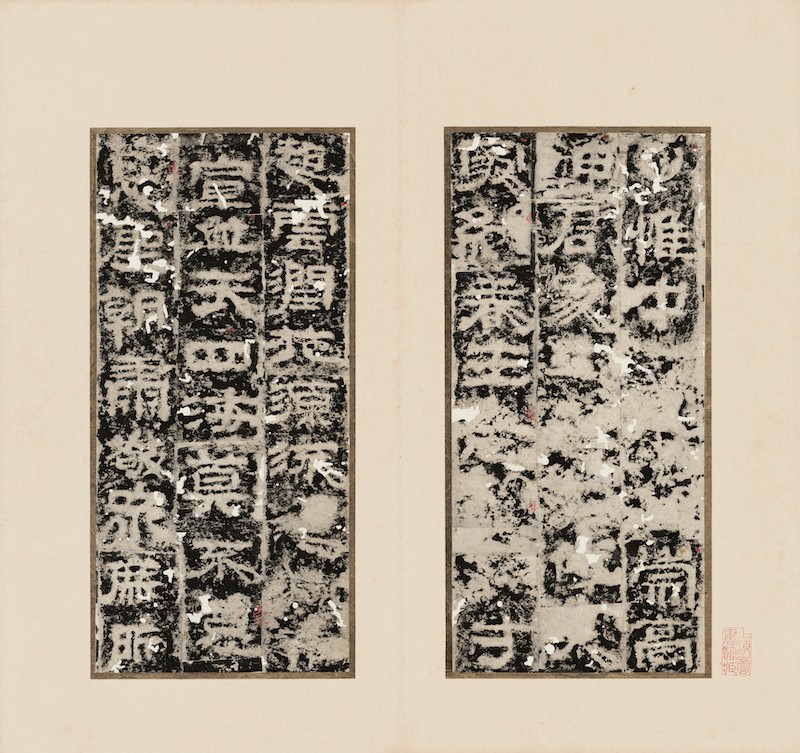
"Taishi Xique Inscription" (Collected by Wang Yirong)
Zhong Wei said that all the exhibits selected for this exhibition are unforgettable masterpieces and treasures in the world. There are no duplicates of rare books and inscriptions. There are many rubbings of Ming Dynasty and early Qing Dynasty, such as Ritual Vessels, Shi Chen, Yi Ying, and Zhang Qian. Judging from the inscriptions and postscripts, none of them are of the same style. Therefore, the principle of selecting the exhibits this time is "under the premise of the same transmission time, taking collections by famous artists and famous inscriptions and postscripts as the first choice, and the quality of the paper and ink for the transmission as the auxiliary condition. Collections by famous artists are the guarantee of the quality and grade of cultural relics in the collection. Famous artists The inscriptions and postscripts reflect the documentary value and cultural relic value of the collection. What we value is the cultural added value behind rare books."
Behind the unforgettable products, each piece has a story.
According to the organizer, this exhibition brings together more than 90 rare works of Han dynasty steles, all of which are national first- and second-grade cultural relics. In terms of rarity, Ming Dynasty stele rubbings can be regarded as the best, while Han stele rubbings from the early Qing Dynasty can be regarded as treasures.
The key exhibits on display include the Cao Quan Stele (the version collected by Yu Fu), the Zhang Qian Stele with the Yin (the Jiang Shi Shu Lou collection), the Ritual Vessel Stele with the Yin (the Tao Zhu collection), the Taishi Xique Inscription (the Wang Yirong collection), The inscriptions on the stone of the Kaimu Temple (from the collection of Li Baoxun), the Diary of the Three Lao Taboos (from the postscripts of Shida Shou), the Monument of Hou Huo of Shanan (from the collection of Pan Zuyin), the cliffs of Liu Pingguo, the general of Qiuci Zuo (the collection from Wang Yirong), etc., nearly half of them are indeed authentic. The Mingtuo of the Han Dynasty stele can be said to be the "best" among the rare books of the Han stele.

Inscription on the stone of Kaimu Temple (copied by Li Baoxun)

Inscription on the stone of Kaimu Temple (copied by Li Baoxun)
Among them, "The Stone Que Inscription of Kaimu Temple" (collected by Li Baoxun) is a rubbing made between the Yuan and Ming Dynasties. It has first-class rubbing work and elegant paper and ink. It is known as "the first copy in the world". "Zhang Qian's Stele with Yin" (collected by Jiang Shishulou) is an epigraphic treasure that stands out from the hundreds of "Zhang Qian's Stele" in the collection. Zhongwei believes that when choosing Han monuments to exhibit, "Zhang Qian Monument" must be selected. "There are hundreds of "Zhang Qian Stele" in the Shanghai Library, and there are probably dozens of them that can meet the collection level. In my mind, there are three to five pieces that can be unforgettable and national treasures. Among these three to five We have to select one or two pieces among them, and the judgment is very challenging. We have three criteria, the first is documentary quality, the second is calligraphy artistry, and the second is a cultural relic." Zhong Wei said.

"The Monument of Zhang Qian and the Yin" (a copy given to him by the Jiang family in the library)
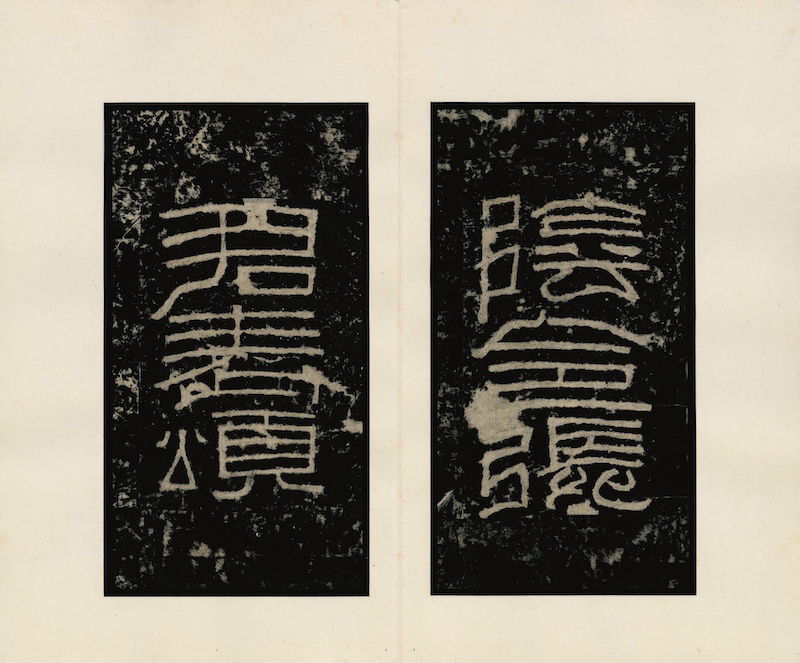
"The Monument of Zhang Qian and the Yin" (a copy given to him by the Jiang family in the library)

"The Monument of Zhang Qian and the Yin" (a copy given to him by the Jiang family in the library)
"Cao Quan Stele" (the edition collected by Yu Fu) was passed down early and has clear characters. It has high documentary quality, calligraphy artistry and cultural relic quality. And it has experienced fire, but fortunately survived.
The "Cao Quan Stele" was erected on October 21, the second year of Zhongping in the Eastern Han Dynasty (185). The inscription mainly describes the family background and political achievements of Cao Quan, an official of the Eastern Han Dynasty, and praises his merits. In the late Ming Dynasty, strong winds broke trees and crushed the stone tablets. After that, the rubbings that people often saw were the versions after the stone tablets were broken.
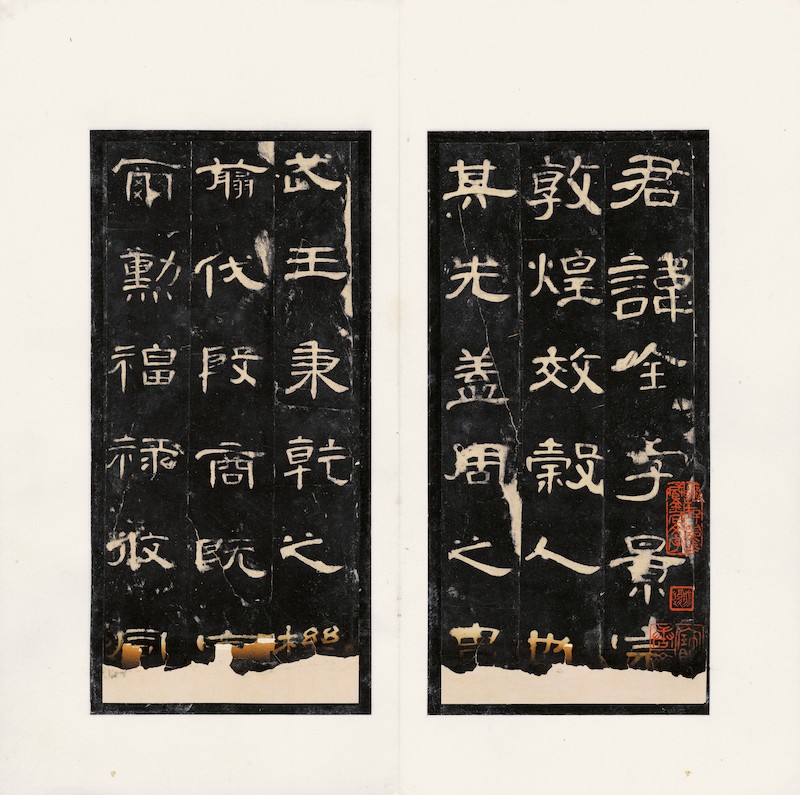
"Cao Quan Stele" (Yu Fu's collection)
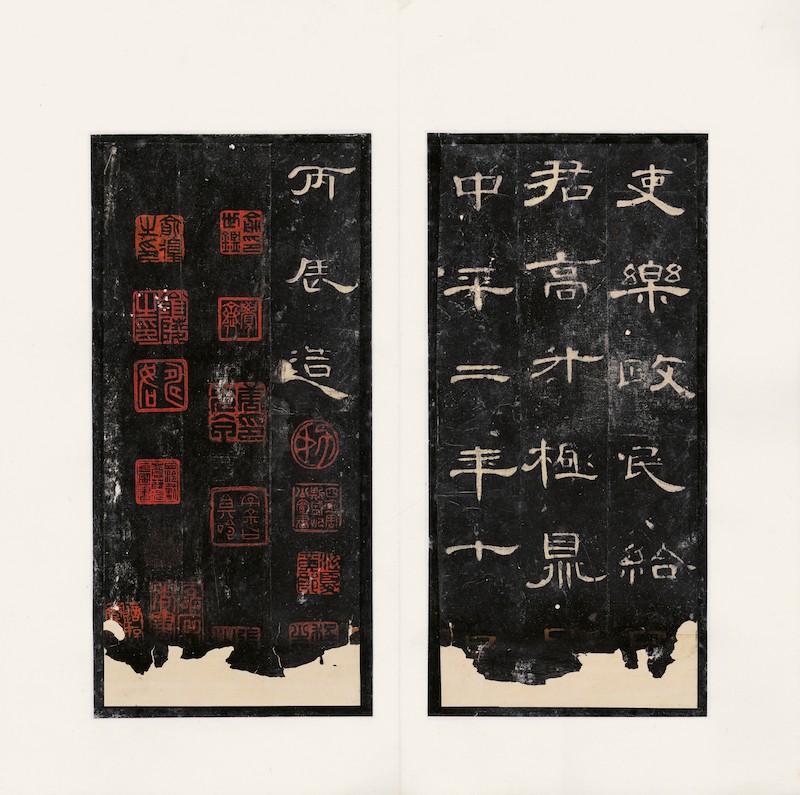
"Cao Quan Stele" (Yu Fu's collection)
Judging from the condition of the inscription, the "Cao Quan Stele" collected by Yu Fu on display this time is an unbroken copy of the Ming rubbings collected by Yu Fu. Therefore, it is extremely valuable. It is second only to the "undamaged copy of the calligraphy" collected by the Shanghai Museum. "top cultural relics. There are traces of fire at the bottom of each page of this rare book. The words on the last line have been burned, but they are still vaguely identifiable. According to Yu Fu’s inscription and postscript at the end of the book, in the autumn of 1915, when Yu Fu was planning to use a glass plate to photocopy the inscriptions on the inscriptions at the Wenming Bookstore, a fire suddenly broke out in the printing factory. All the Ming and Han steles he had collected were burned by the fire, and some of the rubbings were completely destroyed. Fortunately, this volume of "Cao Quan Stele" was relatively large in size and short in inscriptions, so the degree of damage was relatively low. Only the last line of characters was burned. Therefore, today we can still see a relatively complete version of the "Cao Quan Stele".
"The Diary of Three Old Men with Taboos" (postscript version of Shida Shou) is known as "the first monument in Zhejiang and Zhejiang" and almost spread overseas.
"Diary of Three Lao Taboos", also known as "San Lao Stele", was erected between the end of Jianwu and Yongping years (52-57) of the Eastern Han Dynasty. It is one of the earliest extant famous stele of the Eastern Han Dynasty and is ranked "No. 1 in Central Zhejiang." It has been praised as "The Monument" and "The First Monument of the Eastern Han Dynasty". The three elders are the squires who are in charge of education in counties and villages, and they are mostly respected old people.

"Diary of Three Elders with Taboo Words" (postscript version of Shida Shou)
The original stone for the inscription was unearthed in the second year of Xianfeng in the Qing Dynasty (1852) and collected by Zhou Shixiong. In 1919, Shanghai businessman Chen Weiquan purchased the monument from a descendant of the Zhou family and moved it to Shanghai in 1921. At that time, Japanese businessmen wanted to buy it with a lot of money. After Zhejiang antique dealer Mao Jingchou learned of the incident, he negotiated with Shen Baochang, the then magistrate of Shanghai, and Yao Yu, a former Qing Dynasty survivor, to buy the stele. After that, Wu Changshuo, the first president of Xiling Seal Society, and the four founders and others actively worked hard to launch donations and charity sales in Shanghai and Hangzhou and other places. In the end, a total of 11,270 yuan was raised, of which 8,000 yuan was used to buy it back from Chen Weiquan. This famous monument will not spread overseas.

"The Marquis of Shanan Huo Stele" (Pan Zuyin's Collection)

"The Marquis of Shanan Huo Stele" (Pan Zuyin's Collection)
"Shanan Houhuo Stele" (Pan Zuyin's collection), the original stele was erected in the fifth year of Yonghe (140) in the Eastern Han Dynasty. It was discovered by the Qing Dynasty in Hami, Xinjiang, at the southern foot of the Tianshan Mountains. Due to errors in the confirmation of the ambiguous handwriting, there have been several titles. This rubbing was specially made by Pan Zuyin at the request of the border commander stationed in Xinjiang. It is a six-line script. It is the only one in the country and is known as the best in the world. It is now in the collection. Shanghai Library.
After Pan Zuyin obtained the rubbings, it caused a sensation in the gold and stone circles, and successively attracted inscriptions, postscripts and commentaries by Chen Sanli, Chen Jieqi, Bao Kang, Wu Dacheng, Wang Yirong, Zhang Zhidong, Weng Tonghe and others. More than thirty years later, Wu Hufan took over this rubbing and invited a large number of social sages such as Luo Zhenyu, Zou Shouqi, Yuan Hanyun, Cheng Wenlong, and Wu Mei to write inscriptions and postscripts, which finally made it what it is today.
How to appreciate the beauty of rare Han monuments?
Epigraphy and stone inscriptions have always been niche and seem arcane and difficult to understand for the general public. Zhong Wei said that the reason why the Shanghai Library holds such an exhibition on inscriptions is to popularize the knowledge of inscriptions on inscriptions and encourage more people to like and study inscriptions on inscriptions. So how should ordinary audiences appreciate the beauty of rare books on Han dynasty monuments?
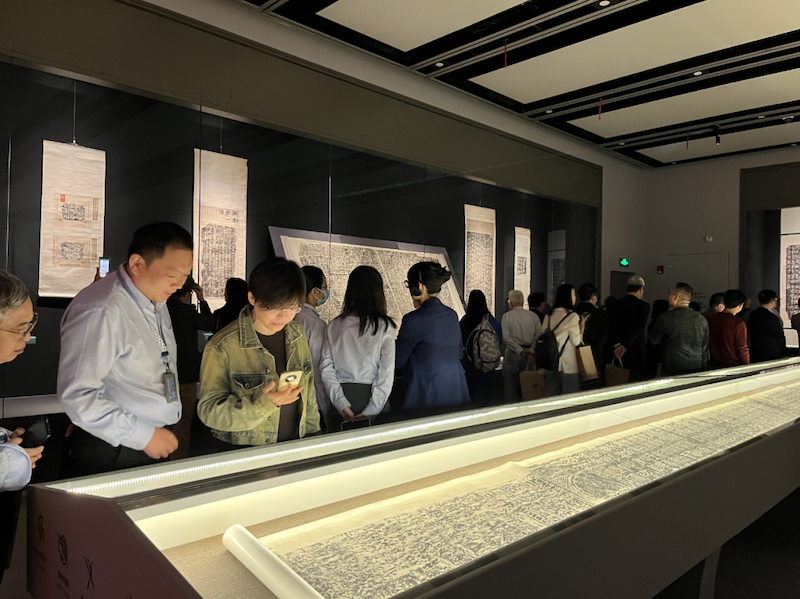
exhibition site
"The cultural content of the epigraphic inscriptions is high, and the threshold for appreciation is also high. For this exhibition, it is best to adopt a learning-oriented exhibition mode. There is no way to achieve the goal of learning the inscriptions through an exhibition and an educational lecture." Zhong Wei said, the audience You can take this exhibition as an opportunity to gradually learn in depth by visiting the exhibition and finding relevant literature. At the same time, different audiences can see different knowledge and appreciate the different beauties of rare books of Chinese stele, such as the beauty of form, the beauty of articles, the beauty of Chinese characters, the beauty of binding, the beauty of inscriptions, and the beauty of seals. He suggested that ordinary viewers can focus on the beauty of calligraphy, View the exhibition from four perspectives: traditional beauty, decoration beauty, and humanistic beauty.

Shi Chenqian's stele (collected by Sun Duoguo)
One look at the calligraphy is beautiful. This exhibition can be said to be a masterpiece of Han stele calligraphy. The Han Dynasty was an extremely important period of development in the history of Chinese calligraphy. At this time, the official script gradually evolved from the Qin seal script and became a unique and dominant font that was widely used. There are various styles of official calligraphy on Han steles. The style of "San Lao Stele" is between seal script and official script. It is ancient and natural. It can be called a living fossil of the evolution of calligraphy from ancient official script to Han official script. "Cao Quan Stele" is one of the representative works of official script in the Han Dynasty. It is beautiful and colorful, with an elegant and stable structure and a smooth and even layout; although "The Ritual Vessel Stele" is in official script, it inherits the brushwork of seal script and is elegant and powerful; "Zhang Qian Stele" is a work from the mature period of official script in the Han Dynasty, with square and simple fonts. Thick and elegant, it can be said to be a representative work of the Han Li Fangbi system.
Second, look at Chuan Tuomei. Chinese rubbing techniques use paper and ink as the medium to preserve, copy and disseminate epigraphic characters in the form of rubbings. Rubbings are made by using a brown brush or brush to embed wet rice paper into the character pattern and ink it. The character pattern has a concave and convex three-dimensional effect.
The Han Dynasty stele has a history of two thousand years. The surface of the stele has been weathered and mottled by time, wind and rain erosion, so large stone flowers will be left on the paper when rubbing. The layers of stone flowers that "bloom" in the long river of history are quite interesting, and you can experience the eternal charm of epigraphic culture.

The inscriptions on the portraits of Wu’s ancestral temple (the original edition of Huang Yi’s examination in the first year of Jiaqing’s reign)

The inscriptions on the portraits of Wu’s ancestral temple (the original edition of Huang Yi’s examination in the first year of Jiaqing’s reign)

The inscriptions on the portraits of Wu’s ancestral temple (the original edition of Huang Yi’s examination in the first year of Jiaqing’s reign)
Third, look at the beautiful binding. Rare books of inscriptions on inscriptions are often valued by collectors of all ages, and their charm is displayed in quaint and exquisite bindings. This exhibition is also a grand prize for the binding of inscriptions and calligraphy. Various forms of inscriptions are on display. We can not only feel the shock of seeing the entire large scroll hanging, but we can also experience the fun of stopping to admire the cut and mounted copy that can be played flat.

The Cliff of Liu Pingguo, the General of the Left in Qiuci (Collected by Wang Yirong)
Fourth, look at the beauty of humanity. In the process of the circulation of rare inscriptions, the seals, inscriptions, and postscripts left by epigraphists of all ages have made rubbings transcend their own functions of preservation and reproduction and become unique cultural relics. For example, the rubbings of "Shanan Hou Huo Stele" bring together the writings of Luo Zhenyu, the founder of modern oracle bone inscriptions research, Wang Yirong, the first discoverer of oracle bone inscriptions, Wu Hufan, a famous calligrapher, painter, and connoisseur, and many other scholars and collectors. They either textual research or record historical facts. , or express your feelings and have a "paper party". The words left behind transcend the boundaries of time and space, allowing the audience to appreciate the research results and appreciation interests of their predecessors, and to appreciate the breadth and depth of traditional Chinese culture.

The opening ceremony of "The Heroes of the Han Dynasty—Exhibition of Rare Books on Han Steles Collected by the Shanghai Library"
In order to cooperate with this exhibition, the Shanghai Library has compiled the book "The Great Han Dynasty - An Exhibition of Rare Books on Han Steles Collected by Shanghai Library", which includes 151 kinds of rare books on Han steles, including all exhibits, and will hold a launch ceremony on the day of the opening ceremony. This exhibition lasts for 2 months and will last until January 7 next year. During the exhibition, expert lectures will also be held on the weekends from November to December to appreciate the infinite charm of Han stele with readers.


